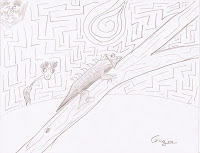Many of you took my suggestion and while looking at Pablo Picasso's "Two Men". This was your introduction to drawing outlines and contour lines. Can you describe the difference between and outline and contour line?
 Craig
CraigVery clean outlines! The contour lines of the hat of the man standing are drawn well, particularly where the brim of the hat meets his forehead. Overall, the proportions of the two men turned out well. You did a good job of capturing their facial expressions. Check the proportions of the face of the man seated. Are they the same in your drawing compared to the reference picture?
Craig's comments: "Thank you for showing me how to draw."
 Elvis
ElvisThe contour lines of the two men are drawn very well, particularly the vest area of the man standing and the form of the body of the man sitting. I like the contour line for the chin of the man standing. You did and excellent job of drawing accurate proportions of the men's bodies, heads, and hats. You also did a superb job of including all of the details such as buttons and facial features. Check the curved contour lines of the men's hats and the neck area of the man sitting.
Elivs' comments: "Thank you for commenting on my Picasso drawing. I am trying to work better on my outlines. And I think I did good on my challenge this week."
 Gage
GageIt looks like you ran out of time on your drawing of the two men. What you've drawn shows sharp outlines and good overall proportions of the man standing. You show the curved lines of his hat and contour line for his chin. Take time to compare your drawing to the reference picture. Do your contour lines show the outside edges of the clothing? You may want to take some time to finish this drawing.
Gage's comments: Thank you, I really like your class and I'm excited to come back on Friday."
 Jaime
JaimeYou got a good start with drawing contour lines. Looks like you needed more time to finish. The contour lines that you drew are showing the form of the man's arm and clothing. Since you started out good contour lines, you may want to take time to finish this drawing.
Jaime's comments: "Rob, I like your class a lot and I think I'm going to learn a lot. Thank you."
 Jared
JaredLooks like you ran short of time while drawing the outlines of the two men. You captured the basic proportions of the man standing. His head was looking pretty good but you erased your guidelines. Keep practicing sketching the contour lines of things. If you can, take some time to finish this drawing.
Jared's comments: Thank you very much for the opportunity to learn how to make beautiful artwork. I really enjoyed our last session together and am really looking forward to the next one. I hope to learn a ton from this experience and maybe make a living out of drawing."
 Leif
LeifGreat job of including the details of the two men. Very good job of drawing accurate proportions of both men with clean lines. Practice taking time to draw light guidelines then carefully drawing the contour lines, like you did on the egret. This will help to make your drawing look more realistic.
Leif's comments: Thank you for teaching me how to draw sea creatures 'Kenny'. Don't worry I know your name is Rob. I just feel more comfortable calling you Kenny."
 Michael
MichaelYour drawing of the Egyptian hieroglyphics shows your improvement of controlling your lines. Since you're interested in hieroglyphics you may want to finish this drawing--you've got a good start! If you'd like to continue
Click here.
Michael's comments: "Thank you Rob for teaching me how to be a better drawer."
 Shaylah
ShaylahExcellent job of drawing the details of both men! You did a very good job of sketching guidelines before finishing with darker contour lines. The contour lines for the chins shows the form of their faces. The contour lines of the vest of the man standing are particularly well drawn. Also, the curved contour line, where the forehead of the man sitting meets the brim of his hat gives depth to your picture. Does the hat of the man standing show accurate curved contour lines? Your line work is improving a lot. Keep practicing drawing accurate contour lines that show the edges and roundness of things.
Shaylah's comments: "Well thank you, I'm excited to learn more techniques in your class. I enjoy being in your art class."

Very good job of drawing the details of the two men. You took the time to draw accurate contour lines for the men's clothing. Your ability to draw proportions is improving with each of your drawings.
Ricky's comments: "I took a lot of your advice about the shading on the crab and blowfish. I first started out drawing the shape of the blofish, then I made sure that it wasn't too dark because then it's hard to erase even though you shouldn't be erasing. Then I started to doodle more with the details of the blowfish. The way that we have to hold the pencil is different than normal. After my attempts of drawing the blowfish I started to work on my crab. But the crab is harder to draw than the fish. I really enjoyed the first class and hope to have many more classes with you teaching."



































